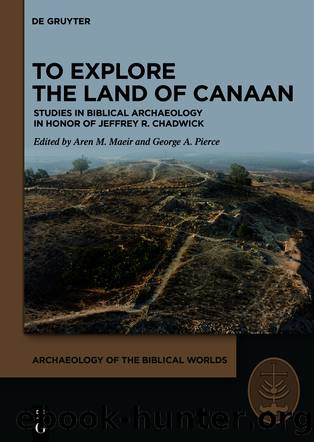To Explore the Land of Canaan by Aren M. Maeir George A. Pierce

Author:Aren M. Maeir, George A. Pierce
Language: eng
Format: epub
Publisher: De Gruyter
Published: 2021-09-24T11:49:43.394000+00:00
Notes
1 Authors are responsible for the following sections: SG-A for the Tell eá¹£-ṢâfÄ«/Gath, Area C, tower; MH-S for Tell eá¹£-ṢâfÄ«/Gath, Area A, and drawings; LAH for overall comments and on the Tell eá¹£-ṢâfÄ«/Gath tower; AMM for Tell eá¹£-ṢâfÄ«/Gath and overall comments; PM for Pantalica; LP for Sardinia. It is with great pleasure we present this article to our dear friend and colleague Jeffrey Chadwick whose interest in architectural planning and modularity in the biblical world (e.g., Chadwick 2020) resonates strongly with Hitchcockâs (1997: esp. 246â47, no. 20 on the pitfalls of metrology) and Militelloâs (2017) interests in modularity, architectural planning, and design in Minoan Crete and in Sicily. LAHâs research was funded by the University of Melbourneâs Special Studies and Universal Grant Program. LAHâs and PMâs research was further supported by the University of Catania, the University of Heidelberg, and the DAAD.
2 For the early (Iron IB) phase of the gate in Area D East, see Maeir (2020a).
3 However, for an alternative interpretation assigning the blocks to layer C6-2a dated to the Iron IIA period, see Gur-Arieh and Maeir (2020).
4 This lower, earlier wall is W20A70C03.
5 The pry hole measures L 16 x W 6 x Depth 5 cm. This large block has both Iron I and Iron II ceramics associated with it, making the date uncertain (Gur-Arieh and Maeir 2020: esp. 184). It is also possible that the stone was reused. A similar parallel can be found in the tower at Maa-Palaeokastro on Cyprus, one of two ashlar buildings on the site built of reused stone (e.g. Karagheorghis and Demas 1988). Other examples of early pry holes have been detected on Cyprus at Hala Sultan Tekke and at Kouklia-Palaepaphos (Hitchcock 2020b: 231â32, 239â42).
6 An exception is found in the nearby Balearic Islands and Iberia (Holt 2014 on the architecture), which may have been involved further afield in the tin trade with Cornwall (see Berger et al. 2019).
7 The similarity takes the form of horned helmets, though the horns are placed in the front of the helmet on âbronzetti,â and carrying a shield and a spear. It should be noted that the âgreavesâ on the Ingot god were not greaves and instead represent a repair and the ingot represents a later addition (e.g., Papasavvas 2011a, 2011b).
8 Zertalâs (2011) claim that el Ahwatâs architecture has connections to Sardinian (and the Shardanu) Nuraghe and successive Sardinian architectural forms seems strained and has been critiqued by Finkelstein and Piasetzky (2007).
Download
This site does not store any files on its server. We only index and link to content provided by other sites. Please contact the content providers to delete copyright contents if any and email us, we'll remove relevant links or contents immediately.
| Bahrain | Egypt |
| Iran | Iraq |
| Israel & Palestine | Jordan |
| Kuwait | Lebanon |
| Oman | Qatar |
| Saudi Arabia | Syria |
| Turkey | United Arab Emirates |
| Yemen |
Empire of the Sikhs by Patwant Singh(22974)
The Wind in My Hair by Masih Alinejad(5033)
Rise and Kill First by Ronen Bergman(4701)
The Templars by Dan Jones(4627)
The Rape of Nanking by Iris Chang(4136)
12 Strong by Doug Stanton(3508)
Blood and Sand by Alex Von Tunzelmann(3138)
Babylon's Ark by Lawrence Anthony(2620)
The History of Jihad: From Muhammad to ISIS by Spencer Robert(2565)
No Room for Small Dreams by Shimon Peres(2316)
The Turkish Psychedelic Explosion by Daniel Spicer(2313)
Inside the Middle East by Avi Melamed(2305)
Gideon's Spies: The Secret History of the Mossad by Gordon Thomas(2303)
Arabs by Eugene Rogan(2260)
The First Muslim The Story of Muhammad by Lesley Hazleton(2217)
Come, Tell Me How You Live by Mallowan Agatha Christie(2212)
Bus on Jaffa Road by Mike Kelly(2101)
Kabul 1841-42: Battle Story by Edmund Yorke(1985)
1453 by Roger Crowley(1956)
